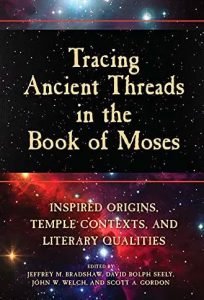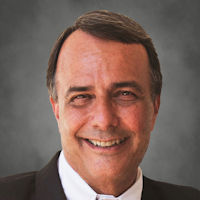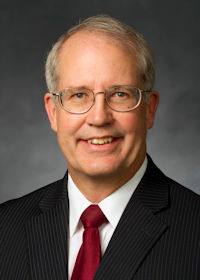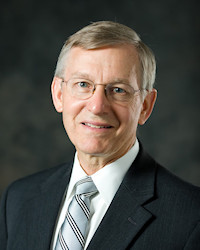Tracing Ancient Threads in the Book of Moses
Inspired Origins, Temple Contexts, and Literary Qualities
Volumes I and II

Proceedings of the Tracing Ancient Threads in the Book of Moses Conference
September 18-19, 2020 and April 23–24, 2021
Edited by Jeffrey M. Bradshaw, David R. Seely, John W. Welch, and Scott Gordon
Published by The Interpreter Foundation
In cooperation with Eborn Books, Salt Lake City
In collaboration with Book of Mormon Central and FAIR (Faithful Answers, Informed Response)
Available Fall 2021 – in time for the Come Follow Me 2022 Old Testament Curriculum
FAIR Bookstore
- PDF: Volumes I and II — $19.99
- Softbound: Two Volume Set
- Hardback: (coming soon)
Eborn Books
- Softbound: Two Volume Set – $49.99
Amazon
- Kindle Replica version: Volume I and Volume II — $9.99 each
- Kindle Replica version: 2 Volume Set — $19.98
- Softbound: 2 Volume Set – $69.99
- Hardback: (coming soon)
Because we believe that the Book of Moses includes authentic history, the possibility of evidence for that belief interests us as scholars. Although the primary intent of Joseph Smith’s translations is to meet the needs of modern readers, not to provide precise matches to texts from other times, we consider significant patterns of resemblance to ancient manuscripts that the Prophet could not have known and of unexpected conformance to conditions imposed by an archaic setting as potential indicators of antiquity that are best explained when the essential element of divine revelation is acknowledged.
Though comparative research can never prove a particular interpretation, it can certainly rule out some and suggest others. In addition, we are persuaded that the process of careful comparison can increase understanding and appreciation of otherwise obscure details in both ancient and modern texts.
Some scholars have come to the conclusion that there is little of genuine value that can be gleaned by comparing modern scripture to writings from antiquity. In part this is because comparative studies have not always been conducted with adequate attention to needed methodological controls. Such carelessness may lead to unreasonable or excessive claims. However, a more important reason for the reluctance of some to embrace the comparative method is that they may see little or nothing of historical value in either the scriptural productions of Joseph Smith or in ancient traditions preserved inside and outside the Bible. If both the Moses of modern scripture and the Moses of ancient Near East tradition are largely, if not exclusively, literary rather than historical figures, why would a detailed comparison of their stories reveal anything real about the material past?
While imperfections in the Bible will not greatly disturb or surprise most Latter-day Saints, their belief that the principal events and characters described in modern scripture have a basis in history and revelation is of great consequence to their faith. How so?
- First, Joseph Smith claimed to have met and conversed with many of these characters, including Moses;
- Second, many ancient figures mentioned in modern scripture are presented at face value as historical characters in historical settings;
- Finally, and most importantly, some of these individuals are recorded as having personally transmitted priesthood authority and keys to Joseph Smith.
For these reasons, those who believe that Joseph Smith met, conversed with, wrote about, spoke about, and was given authority by divinely sent personages who formerly lived on earth also embrace by implication the idea that authentic history sits behind the records of the Prophet’s visions, teachings, translations, and revelations.
Table of Contents
Volume I
Keynote Overviews
-
Adam, Eve, the Book of Moses, and the Temple: The Story of Receiving Christ’s Atonement
Bruce C. Hafen and Marie K. Hafen
Mormon, Moses, and the Representation of Reality
Richard L. Bushman
Inspired Origins and Historical Contexts
-
How We Got the Joseph Smith Translation, the Book of Moses, and Joseph Smith—Matthew
Kent P. Jackson
The Doctrine and Covenants and the Book of Moses: An Outpouring of Revelations and the Beginning of Joseph Smith’s “New Translation” of the Bible
Kerry Muhlestein
“We Believe the Bible to Be the Word of God, as Far as It Is Translated Correctly”: Latter-day Saints and Historical Biblical Criticism
David Rolph Seely
The Priestly Interests of Moses the Levite
John W. Welch, with Jackson Abhau
The Bible Before and After: Interpretation and Translation in Antiquity and the Book of Moses
Avram R. Shannon
The Book of Moses as a Pre–Augustinian Text: A New Look at the Pelagian Crisis
Terryl L. Givens
“Strong Like unto Moses”: The Case for Ancient Roots in the Book of Moses Based on Book of Mormon Usage of Related Content Apparently from the Brass Plates
Jeff Lindsay and Noel B. Reynolds
The Book of Moses as a Temple Text
Jeffrey M. Bradshaw
“This Thing Is a Similitude”: A Typological Approach to Moses 5:4–15 and Ancient Apocryphal Literature
David Calabro
An Early Christian Context for the Book of Moses
David Calabro
Centralizing Scriptural Resources
Ryan Dahle
Volume II
Literary Explorations
-
The Book of Moses: Exploring the World OF the Text
David Rolph Seely
The Original English of the Book of Moses and What It Indicates about the Book’s Authorship
Stanford A. Carmack
Hebraisms in the Book of Moses: Laying Groundwork and Finding a Way Forward
Jonathon Riley
“The Word of My Power”: The Divine Word in the Book of Moses
Matthew L. Bowen
Moses 1: Temple Echoes in the Heavenly Ascent of Moses
-
Moses 1 and the Apocalypse of Abraham: Twin Sons of Different Mothers?
Jeffrey M. Bradshaw, David J. Larsen, and Stephen T. Whitlock
“I Am a Son of God”: Moses’ Prophetic Call and Ascent into the Divine Council
Stephen O. Smoot
“Made Stronger Than Many Waters”: The Purported Sacred Names of Moses as a Series of Keywords
Jeffrey M. Bradshaw and Matthew L. Bowen
Moses 6–7: Enoch’s Divine Ministry
-
“Enoch Walked with God, and He Was Not”: Where Did Enoch Go after Genesis?
Jared W. Ludlow
Moses 6–7 and the Book of Giants: Remarkable Witnesses of Enoch’s Ministry
Jeffrey M. Bradshaw
Man and Son of Man: Probing Theology and Christology in the Book of Moses and in Jewish and Christian Tradition
S. Kent Brown and Jeffrey M. Bradshaw
About the Editors

Jeffrey M. Bradshaw
Jeffrey M. Bradshaw (PhD, Cognitive Science, University of Washington) is a Senior Research Scientist at the Florida Institute for Human and Machine Cognition (IHMC) in Pensacola, Florida (www.ihmc.us/groups/jbradshaw; en.wikipedia.org/wiki/Jeffrey_M._Bradshaw). His professional writings have explored a wide range of topics in human and machine intelligence (www.jeffreymbradshaw.net). Jeff has been the recipient of several awards and patents and has been an adviser for initiatives in science, defense, space, industry, and academia worldwide. Jeff has written detailed commentaries on the Book of Moses and Genesis 1–11 and on temple themes in the scriptures. For Church-related publications, see www.TempleThemes.net. Jeff was a missionary in France and Belgium from 1975–1977, and his family has returned twice to live in France. He and his wife, Kathleen, are the parents of four children and fourteen grandchildren. From July 2016-September 2019, Jeff and Kathleen served missions in the Democratic Republic of Congo Kinshasa Mission office and the DR Congo Kinshasa Temple. They currently live in Nampa, Idaho.

David R. Seely
David Rolph Seely is a professor of Ancient Scripture at Brigham Young University. He earned his undergraduate degree in Greek and a master’s degree in Classics from Brigham Young University and a Ph.D. from the University of Michigan in ancient and biblical studies. He is a member of the international team of scholars that translated and published the Dead Sea Scrolls, and published together with Professor Moshe Weinfeld the Barkhi Nafshi hymns from Qumran. He has co-authored with Richard Holzapfel and Dana Pike Jehovah and the World of the Old Testament and with William Hamblin Solomon’s Temple in Myth and History.

John W. Welch
John W. (“Jack”) Welch has been a law professor at BYU since 1980, where he has taught classes on Business Associations, Tax-Exempt Organizations, Ancient Near Eastern Law in the Book of Mormon, Jewish and Roman Law in the New Testament, and Joseph Smith and Early American Law. He and his wife Jeannie received master’s degrees at BYU in 1970, and then lived in England and North Carolina, where he did graduate work at Oxford and received his JD from Duke University. He practiced law with O’Melveny & Myres in Los Angeles 1975-1980, and has been a longtime member of the Society of Biblical Literature and of the Jewish Law Association. Over the years, Jack’s work on the on chiasmus has become widely known in scholarly and religious circles. His innovative studies about the trial of Jesus, the Sermon on the Mount, and the Good Samaritan have been published in BYU Studies and elsewhere. He founded the Foundation for Ancient Research and Mormon Studies (FARMS) in 1979, and was one of the editors of Macmillan’s Encyclopedia of Mormonism (1992). Currently he is the chair and editor in chief of Book of Mormon Central. His book entitled The Parables of Jesus: Revealing the Plan of Salvation, features commissioned paintings by Argentinian artist Cocco Santángelo and is co-authored with his wife Jeannie. They have four children and 17 grandchildren.

Scott Gordon
Scott Gordon serves as President of Faithful Answers, Informed Response (FAIR), a non-profit corporation staffed by volunteers dedicated to helping members deal with issues raised by critics of the Church of Jesus Christ of Latter-day Saints. The organization Website is FAIR. Scott has an MBA from Brigham Young University, and a BA in Organizational Communications from Brigham Young University. He is currently an instructor of business and technology at Shasta College in Redding, California. Scott has held many positions in The Church of Jesus Christ of Latter-day Saints including serving as ward mission leader, seminary teacher, stake young men’s president, Sunday school teacher, and bishop. He is married and has five children.


